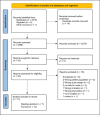Is endoscopic combined intrarenal surgery ready for primetime in endourology? Outcomes from a systematic review and meta-analysis
- PMID: 35937663
- PMCID: PMC9326699
- DOI: 10.5173/ceju.2022.0049
Is endoscopic combined intrarenal surgery ready for primetime in endourology? Outcomes from a systematic review and meta-analysis
Abstract
Introduction: We aimed to review the outcomes of endoscopic combined intrarenal surgery (ECIRS) as compared to conventional percutaneous nephrolithotomy (PCNL) for kidney stones.
Material and methods: We performed a systematic literature review using MEDLINE, EMBASE, and Cochrane Central Controlled Register of Trials. We included all studies comparing ECIRS and conventional PCNL. Surgical time, hemoglobin drop, and postoperative stay were pooled using the inverse variance of the mean difference (MD) with a random effect, 95% confidence intervals (CI), and p-values. Complications, stone-free rate, and retreatment were assessed using Cochran-Mantel-Haenszel method with random effect model and expressed as odds ratio (OR), 95% CI, and p-values.
Results: A total of 17 studies were included. Surgical time and mean postoperative length did not significantly differ between the groups (MD -8.39 minutes 95%CI -21.30, 4.53, p = 0.20; 5.09 days 95%CI -19.51, 29.69, p = 0.69). Mean hemoglobin drop was significantly lower in the ECIRS group (MD -0.56 g/dl 95%CI -1.08, -0.05, p = 0.03), while blood transfusion rate did not differ between the two groups (OR 0.88 95%CI 0.64, 1.23, p = 0.15). While the incidence of postoperative sepsis did not differ between the two groups (OR 0.52 95% CI 0.17, 1.59, p = 0.25), the incidence of postoperative fever was lower in the ECIRS group but the difference was not significant (OR 0.61 95%CI 0.35, 1.06, p = 0.08). The stone-free rate was significantly higher in the PCNL group (OR 2.52 95%CI 1.64, 3.90, p <0.0001) and the retreatment rate was lower in the ECIRS group (OR 0.34 95%CI 0.14, 0.87, p = 0.002).
Conclusions: ECIRS showed shorter operative time, lower complication rate, and retreatment compared to PCNL. Conventional PCNL showed a higher stone-free rate.
Keywords: endoscopic combined intrarenal surgery; kidney stone; percutaneous nephrolithotomy; retrograde intrarenal surgery.
Copyright by Polish Urological Association.
Conflict of interest statement
The authors declare no conflicts of interest.
Figures







Similar articles
-
Endoscopic Combined Intrarenal Surgery vs Percutaneous Nephrolithotomy for Large and Complex Renal Stone: A Systematic Review and Meta-Analysis.J Endourol. 2022 Jul;36(7):865-876. doi: 10.1089/end.2021.0761. Epub 2022 Jun 24. J Endourol. 2022. PMID: 35152754
-
Endoscopic Combined Intrarenal Surgery Versus Percutaneous Nephrolithotomy for Complex Renal Stones: A Systematic Review and Meta-Analysis.J Pers Med. 2022 Mar 28;12(4):532. doi: 10.3390/jpm12040532. J Pers Med. 2022. PMID: 35455648 Free PMC article. Review.
-
The Impact of Lasers in Percutaneous Nephrolithotomy Outcomes: Results from a Systematic Review and Meta-Analysis of Randomized Comparative Trials.J Endourol. 2022 Feb;36(2):151-157. doi: 10.1089/end.2021.0507. J Endourol. 2022. PMID: 34314230
-
The Safety and Efficacy of Endoscopic Combined Intrarenal Surgery (ECIRS) versus Percutaneous Nephrolithotomy (PCNL): A Systematic Review and Meta-Analysis.Adv Urol. 2022 Jul 18;2022:1716554. doi: 10.1155/2022/1716554. eCollection 2022. Adv Urol. 2022. PMID: 35898579 Free PMC article.
-
Endoscopic combined intrarenal surgery for large calculi: simultaneous use of flexible ureteroscopy and mini-percutaneous nephrolithotomy overcomes the disadvantageous of percutaneous nephrolithotomy monotherapy.J Endourol. 2014 Jan;28(1):28-33. doi: 10.1089/end.2013.0361. Epub 2013 Oct 24. J Endourol. 2014. PMID: 23987470
Cited by
-
Current role of endoscopic combined intrarenal surgery in the management of renal stones: A scoping review.Indian J Urol. 2023 Oct-Dec;39(4):274-284. doi: 10.4103/iju.iju_249_23. Epub 2023 Sep 29. Indian J Urol. 2023. PMID: 38077207 Free PMC article.
-
The Consecutive 200 Cases of Endoscopic-Combined Intrarenal Surgery: Comparison between Standard and Miniature Surgeries.Medicina (Kaunas). 2023 Nov 8;59(11):1971. doi: 10.3390/medicina59111971. Medicina (Kaunas). 2023. PMID: 38004020 Free PMC article.
-
Extracorporeal shock wave lithotripsy, ureterolithotripsy, and percutaneous nephrolithotripsy challenges in managing spinal cord neuropathy patients. Lessons learned from a scoping review.Cent European J Urol. 2024;77(1):89-110. doi: 10.5173/ceju.2023.123. Epub 2024 Jan 11. Cent European J Urol. 2024. PMID: 38645817 Free PMC article.
-
Prevention of complications in endourological management of stones: What are the basic measures needed before, during, and after interventions?Asian J Urol. 2024 Apr;11(2):180-190. doi: 10.1016/j.ajur.2023.04.003. Epub 2023 Jul 27. Asian J Urol. 2024. PMID: 38680580 Free PMC article. Review.
-
Endoscopic Combined Intrarenal Surgery: best practices and future perspectives.Int Braz J Urol. 2024 Nov-Dec;50(6):714-726. doi: 10.1590/S1677-5538.IBJU.2024.9921. Int Braz J Urol. 2024. PMID: 39226443 Free PMC article. Review.
References
-
- Türk C, Petřík A, Sarica K, et al. EAU Guidelines on Interventional Treatment for Urolithiasis. Eur Urol. 2016;69:475–482. - PubMed
-
- Assimos D, Krambeck A, Miller NL, et al. Surgical Management of Stones: American Urological Association/Endourological Society Guideline, PART I. J Urol. 2016;196:1153–1160. - PubMed
-
- Cracco CM, Scoffone CM. ECIRS (Endoscopic Combined Intrarenal Surgery) in the Galdakao-modified supine Valdivia position: a new life for percutaneous surgery? World J Urol. 2011;29:821–827. - PubMed
-
- Scoffone CM, Cracco CM, Cossu M, Grande S, Poggio M, Scarpa RM. Endoscopic combined intrarenal surgery in Galdakao-modified supine Valdivia position: a new standard for percutaneous nephrolithotomy? Eur Urol. 2008;54:1393–1403. - PubMed
-
- Hamamoto S, Yasui T, Okada A, et al. Efficacy of endoscopic combined intrarenal surgery in the prone split-leg position for staghorn calculi. J Endourol. 2015;29:19–24. - PubMed
Publication types
LinkOut - more resources
Full Text Sources
